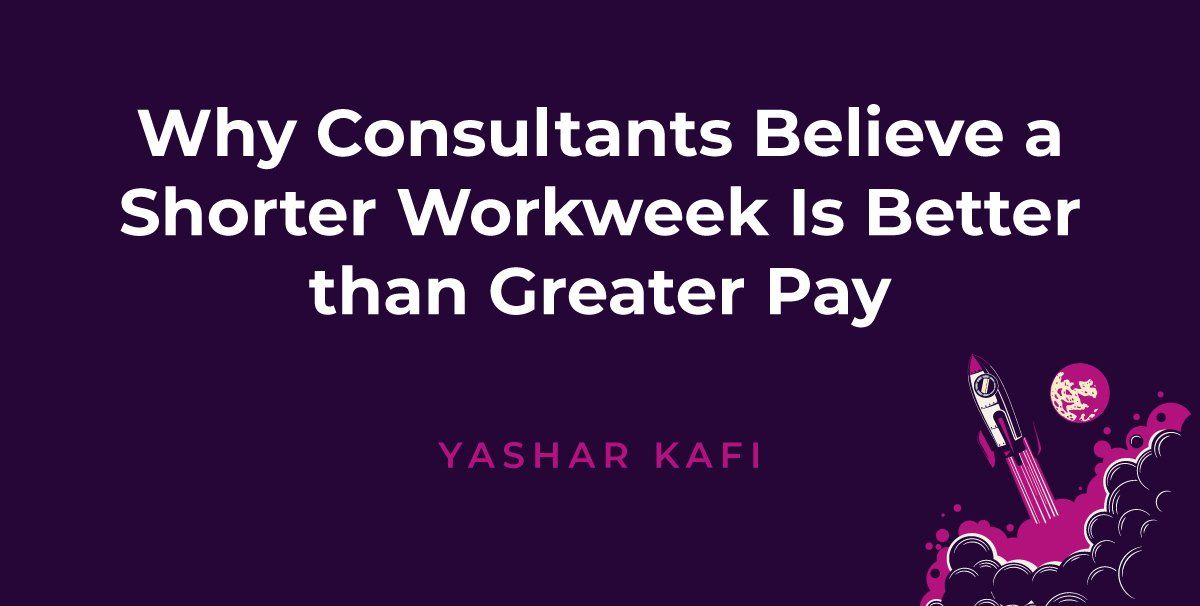Why Consultants Believe a Shorter Workweek Is Better than Greater Pay
You would be hard-pressed to find many people who would disagree when presented with the idea of a shorter workweek. But beyond just popular opinion, research has even shown the numerous benefits of a briefer workweek—even going so far as to attest that a shorter workweek is better than higher pay.
Our consultants at AMPlify agree with this claim, and this article will cover reasons why a shorter workweek outshines a bigger salary.
Reassessing the Modern Workplace
The pandemic was an unexpected catalyst that caused us to radically reassess the way we work. A new workplace is now emerging, with a renewed focus on better work-life balance, more support for mental health, increased flexibility (including remote working capabilities), and more.
As part of this improved work-life balance, supporters argue that a shorter workweek is vital and that taking it even trumps the benefits of higher pay.
According to a BBC article addressing the case for a shorter workweek, adopting a reduced-hours working model can go a long way in remedying what currently ails us. The side benefits include greater employee productivity, improved health, and an uptick in happiness levels—all of which are things that money (a higher salary) simply cannot buy.
More Time
Among the most prized advantage of adopting a shorter workweek is having more time. Time is one of the few things in life that is often characterized as being priceless, and we have to agree.
Many statistics support this, and one of the most alarming statistics discusses how much we are currently working. Data reveals that 94% of workers in the professional service industry work over 50 hours a week (far beyond a “normal” workweek that consists of roughly 40 hours a week and 8 hours per day). Even worse, 48% of workers surveyed admitted that they would classify themselves as “workaholics”—even going so far as to work on the weekend, never really “unplugging” from the office.
This is alarming because each of those extra hours we work is essentially eating away at the time we have for other vital things: time with family and friends, for exercise, mental rest and rejuvenation, and much more.
We need more time—our time, not that belonging to the office.
The Pre-industrial Workforce Had a Shorter Week
Before capitalism hit the stage, most workers did not work long hours, and if they did, the day was full of breaks. Also, the approach to work was far more relaxed—some might go so far as to even label it as borderline leisurely. Economist and author Juliet B. Schor explains it in greater detail in her book, The Overworked American: The Unexpected Decline of Leisure.
Capitalism may have brought about far higher wages (pay), but it took away the hours off enjoyed by our pre-industrial ancestors. According to Schor, “One of capitalism’s most durable myths is that it has reduced human toil.”
More Things Do Not Mean More Happiness
Although many of us have already learned this lesson the hard way by trying to fill voids in our lives with material possessions, an article by the Harvard Business Review pointed out that research has suggested that “prioritizing money over time may actually undermine our happiness.”
The article also highlighted that “80% of people under 30 reported deriving more happiness from buying experiences” rather than material items.
A Consultant’s Observation – More Time
At AMPlify, we see the results firsthand of employees that are given more time, and they are overwhelmingly positive.
It comes down to appreciation and employers showing it to their employees. One way is by giving employees more time to live because they do have a life outside of the office.
The bottom line is that employees love to feel like their employer values their time. And when an employer shows that they are aware of this and care by giving their workers the time to invest in their personal lives, the workplace culture becomes more positive.
Can Organizations Support Inflated Wages?
If you haven’t been swayed by the mental health factors and appeals of working less, let’s talk money. The way things are going isn’t sustainable. Inflation is out of control.
To compete with larger organizations, smaller companies have to look into other ways to give employees stability and happiness. If employees can accomplish their tasks in less than 40 hours, why are we making them stay? And an even bigger question: If we keep this up, will the Great Resignation continue?
To learn more about how you can restructure your workforce, contact us today.




